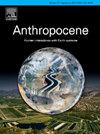Riverine nutrient differentiation patterns and pollutant flux behavior affecting the mainstream-tributary coupling environment in a mega drainage basin, PR China
IF 3.9
2区 地球科学
Q2 ENVIRONMENTAL SCIENCES
引用次数: 0
Abstract
The Yangtze River Basin (YRB) was facing increasing ecological stress due to nutrient-induced eutrophication, yet the coupling response of natural and anthropogenic factors on the interactions among hydrological processes, water quality, and pollutant fluxes across mainstream-tributary systems remain inadequately quantified. This study integrated water quality index (WQI) assessment with multivariate statistics to analyze spatiotemporal patterns of river flow, water quality, and pollutant fluxes between 2017 and 2022. Results revealed an overall improvement in water quality (average WQI increase of 11.6 %), though persistent phosphorus limitation (TN:TP > 19.4) sustained eutrophication risk. Significant spatial heterogeneity was identified between upper and lower basins. The 2022 drought reduced annual flow by 22.0 % relative to decadal averages, diminishing tributary nutrient retention and elevating downstream pollutant fluxes. Cluster analysis identified four pollutant flux regimes, with strong monthly correlations between river flow and nitrogen/phosphorus fluxes (p < 0.001). Analysis of variance confirmed significant spatial differences in TN and TP fluxes across sub-basins, with monthly flux-flow-concentration correlations exceeding annual trends. Redundancy analysis highlighted stronger anthropogenic impacts on pollutant behavior in the lower basin. The Three Gorges Dam (TGD) significantly intercepted pollutants and altered elemental cycling pathways. These findings established a quantitative framework for coupled hydrologic-biogeochemical processes in mega river systems and inform targeted water quality management strategies.
影响大型流域干支流耦合环境的河流养分分异模式和污染物通量行为
长江流域因营养富营养化而面临日益严重的生态压力,但自然和人为因素对水文过程、水质和干支流系统污染物通量相互作用的耦合响应仍未得到充分量化。本研究将水质指数(WQI)评价与多元统计相结合,分析了2017 - 2022年河流流量、水质和污染物通量的时空格局。结果显示,水质总体改善(平均WQI增加11.6 %),但持续磷限制(TN:TP > 19.4)持续富营养化风险。上下盆地间存在显著的空间异质性。与年代际平均值相比,2022年的干旱使年流量减少了22.0% %,减少了支流的营养保留,提高了下游的污染物通量。聚类分析确定了四种污染物通量,河流流量和氮/磷通量之间具有很强的月相关性(p <; 0.001)。方差分析证实,各子流域全氮和全磷通量存在显著的空间差异,月通量-流量-浓度相关性大于年趋势。冗余分析强调了对下游流域污染物行为的强烈人为影响。三峡大坝截流了大量污染物,改变了元素循环路径。这些发现为特大河流系统的水文-生物地球化学耦合过程建立了定量框架,并为有针对性的水质管理策略提供了信息。
本文章由计算机程序翻译,如有差异,请以英文原文为准。
求助全文
约1分钟内获得全文
求助全文
来源期刊

Anthropocene
Earth and Planetary Sciences-Earth and Planetary Sciences (miscellaneous)
CiteScore
6.30
自引率
0.00%
发文量
27
审稿时长
102 days
期刊介绍:
Anthropocene is an interdisciplinary journal that publishes peer-reviewed works addressing the nature, scale, and extent of interactions that people have with Earth processes and systems. The scope of the journal includes the significance of human activities in altering Earth’s landscapes, oceans, the atmosphere, cryosphere, and ecosystems over a range of time and space scales - from global phenomena over geologic eras to single isolated events - including the linkages, couplings, and feedbacks among physical, chemical, and biological components of Earth systems. The journal also addresses how such alterations can have profound effects on, and implications for, human society. As the scale and pace of human interactions with Earth systems have intensified in recent decades, understanding human-induced alterations in the past and present is critical to our ability to anticipate, mitigate, and adapt to changes in the future. The journal aims to provide a venue to focus research findings, discussions, and debates toward advancing predictive understanding of human interactions with Earth systems - one of the grand challenges of our time.
 求助内容:
求助内容: 应助结果提醒方式:
应助结果提醒方式:


